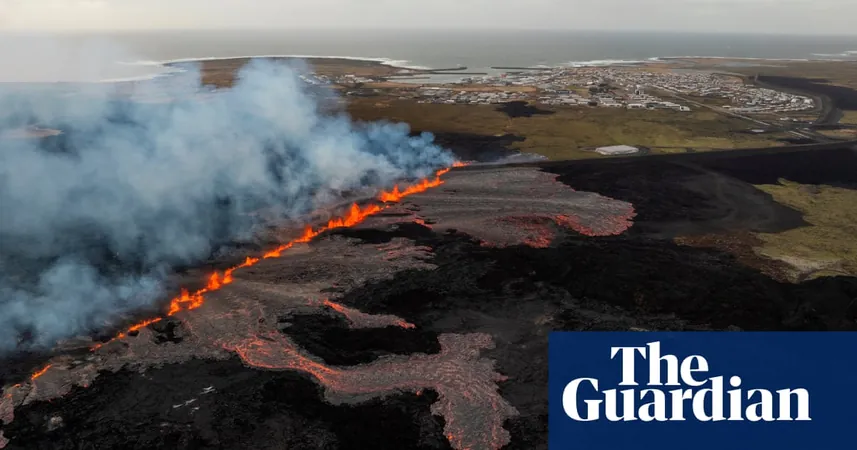
The Magnetic North Pole is on the Move Again: What This Means for Our Navigation Systems
2025-04-03
Author: Chun
The Magnetic North Pole is on the Move Again: What This Means for Our Navigation Systems
The magnetic north pole is on the verge of another shift, inching ever closer to Siberia. Scientists have just unveiled the latest update of the World Magnetic Model (WMM), a crucial recalibration that will impact navigation systems used worldwide—ranging from aircraft and ships to the smartphones we rely on daily.
Understanding Earth's Invisible Magnetic Dance
Unlike the geographically fixed North Pole, magnetic north is influenced by the constant movement of molten iron in Earth’s outer core. This turbulent flow generates our planet's magnetic field, a dynamic force that is essential not only for navigation but also for shielding us from solar radiation.
Since its discovery by British explorer James Clark Ross in 1831 in northern Canada, the magnetic north pole has traversed thousands of kilometers. From the year 2000 onward, it has shifted away from Canadian territory and continued its journey toward Russia.
The pole's movements aren't straightforward; they have varied significantly over the years. In the '90s, the pole accelerated to startling speeds of up to 55 kilometers per year, only to slow down to about 35 kilometers per year post-2015. The dramatic deviations from predicted paths prompted scientists to release an unscheduled WMM update in 2019.
The Latest World Magnetic Model Update
The WMM, developed collaboratively by the British Geological Survey and the National Oceanic and Atmospheric Administration (NOAA), receives an update every five years. This model serves as critical data for GPS systems and is vital for global military operations as well as civil shipping and aviation.
On December 17, researchers released both a standard and a new high-resolution version of the model. The standard model provides a resolution of approximately 3,300 kilometers at the equator, while the high-res version sharpens this to around 300 kilometers, allowing for more precise navigation.
While everyday GPS devices utilize the standard model, the high-resolution data will soon be integrated by military systems and major airlines, ensuring they operate with the most accurate information available.
Dr. William Brown, a geophysicist at the British Geological Survey, emphasized that this model update necessitates recalibrating a "huge number of complex navigation systems across all kinds of equipment."
The Challenges of Predicting Magnetic Movements
Forecasting the magnetic pole's trajectory largely depends on extrapolations from recent data. As Dr. Arnaud Chulliat, a senior research scientist at the University of Colorado Boulder and NOAA’s National Centers for Environmental Information, points out, "The more you wait to update the model, the larger the error becomes." Thus, while projections suggest the magnetic pole will continue its drift toward Russia, the uncertainty around future speeds remains.
Dr. Brown added that, while a new model release before the scheduled update in 2030 isn’t expected, unexpected changes in the pole's rate could alter this timeline.
A Storied Past—And a Possible Future of Reversals
Earth's magnetic field has a complex history. Geological evidence shows that the magnetic poles have undergone significant polarity reversals—where north and south switch places—every million years or so. The last significant reversal occurred between 750,000 and 780,000 years ago.
These flips could weaken the magnetic field temporarily, exposing the planet to increased solar radiation, which in turn could disrupt satellite systems, radio communications, and even animal navigation. Species like whales, sea turtles, butterflies, and migratory birds rely heavily on the magnetic field, so a reversal could drastically impact their migratory patterns.
While the Earth has endured many of these flips throughout history, none have happened during our modern technological era. According to Dr. Brown, should such an event occur today, "it would certainly be an interesting time for engineers to adapt our technology to, but hopefully, it would build up slowly over centuries rather than manifesting suddenly."


 Brasil (PT)
Brasil (PT)
 Canada (EN)
Canada (EN)
 Chile (ES)
Chile (ES)
 Česko (CS)
Česko (CS)
 대한민국 (KO)
대한민국 (KO)
 España (ES)
España (ES)
 France (FR)
France (FR)
 Hong Kong (EN)
Hong Kong (EN)
 Italia (IT)
Italia (IT)
 日本 (JA)
日本 (JA)
 Magyarország (HU)
Magyarország (HU)
 Norge (NO)
Norge (NO)
 Polska (PL)
Polska (PL)
 Schweiz (DE)
Schweiz (DE)
 Singapore (EN)
Singapore (EN)
 Sverige (SV)
Sverige (SV)
 Suomi (FI)
Suomi (FI)
 Türkiye (TR)
Türkiye (TR)
 الإمارات العربية المتحدة (AR)
الإمارات العربية المتحدة (AR)